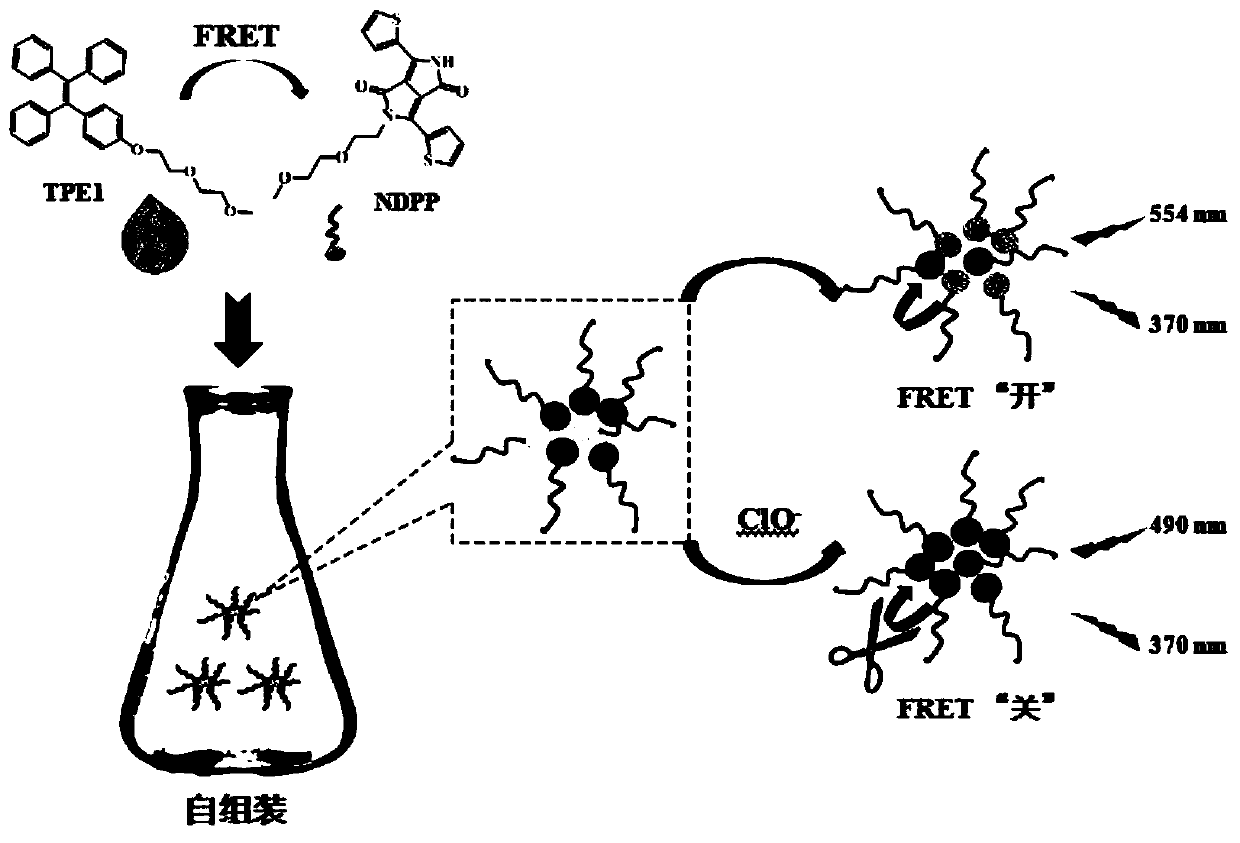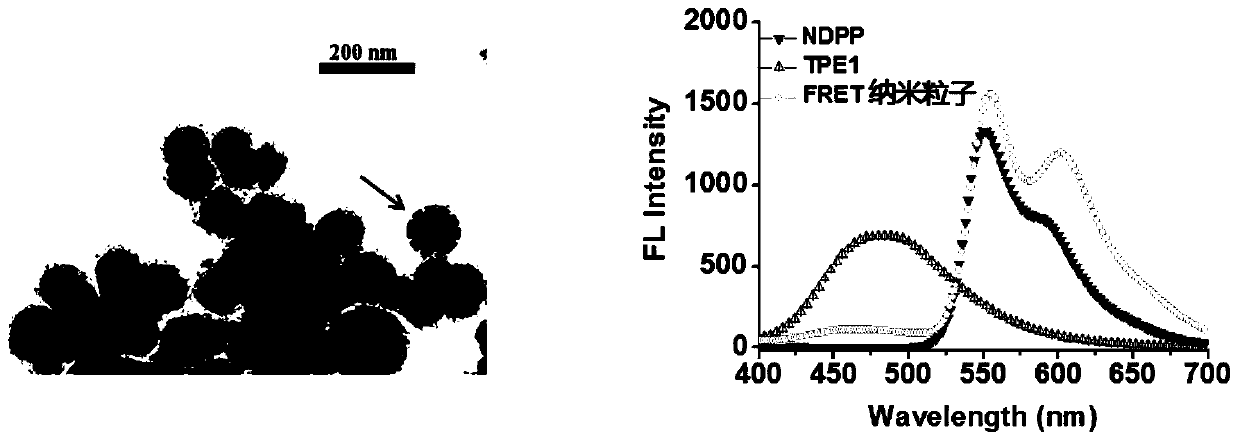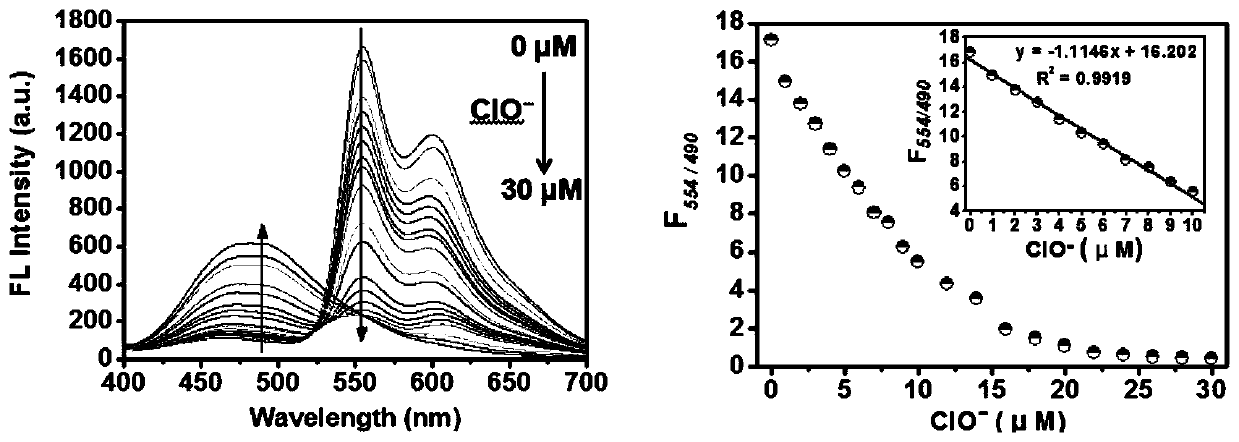Application of Diketopyrrolopyrrole Compounds/Tetraphenylethylene Compounds Composite Nanoparticles in the Detection of Hypochlorite Ions
A technology of diketopyrrolopyrrole and composite nanoparticles, which is applied in nanotechnology, nanotechnology, nanotechnology for materials and surface science, etc., to achieve strong fluorescence emission, which is conducive to large-scale production applications, high selectivity and Effect of Sensitivity Ratiometric Assays
- Summary
- Abstract
- Description
- Claims
- Application Information
AI Technical Summary
Problems solved by technology
Method used
Image
Examples
Embodiment 1
[0036] Preparation of FRET nanoparticles based on thienylpyrrolopyrrole diketopic derivatives. Such as figure 1 As shown, this embodiment uses two kinds of alkoxy (oligopolyethylene glycol) modified fluorescent molecules (NDPP and TPE1, both molecular formulas are as follows figure 1 shown) as raw materials to prepare FRET nanoparticles. In water, add two fluorescent compounds at a ratio of 1:4 of NDPP:TPE1 to make the total concentration 50 μM / L. After ultrasonication for 1 minute, the desired composite nanoparticles were prepared. Such as figure 2 As shown, the left figure shows the particle size and morphology of FRET nanoparticles measured by transmission electron microscopy (TEM), indicating that co-assembly of NDPP and TPE1 can obtain spherical regular particles. figure 2 The middle right panel shows the fluorescence emission map of the nanoparticles. By comparison, it can be seen that after mixing with NDPP, the fluorescence intensity of TPE1 particles is about 8...
Embodiment 2
[0038] FRET nanoparticles on ClO - The fluorescence emission spectrum of the response is as image 3 shown. In aqueous solution, FRET nanoparticles FRET nanoparticles have emission peaks at 490nm and 554nm, which correspond to the characteristic fluorescence emission of TPE1 and NDPP, respectively. With ClO - With the addition of , the fluorescence of TPE1 gradually increased, while that of NDPP gradually decreased. pass image 3 The slope of the fitted curve obtained in the right figure in the middle can be calculated, the FRET nanoparticles in water to ClO- The detection limit can reach 92nM, which can be used for ClO in water environment - real-time monitoring.
Embodiment 3
[0040] FRET nanoparticles on ClO - The specificity of the response is examined as Figure 4 shown. Prepare 8 parts of aqueous solution of FRET nanoparticles with PBS buffer, number 1-8. Then add water, H 2 o 2 , · Oh, 1 o 2 ,NO · ,ONOO - ,t-BuOOH and ClO - . The spectrum shows that: in addition to ClO - In addition, other reactive oxygen species had almost no effect on the fluorescence emission of the solution. This comparative experiment shows that the FRET nanoparticles in the present invention are in ClO - Good selectivity in detection.
PUM
 Login to View More
Login to View More Abstract
Description
Claims
Application Information
 Login to View More
Login to View More - R&D
- Intellectual Property
- Life Sciences
- Materials
- Tech Scout
- Unparalleled Data Quality
- Higher Quality Content
- 60% Fewer Hallucinations
Browse by: Latest US Patents, China's latest patents, Technical Efficacy Thesaurus, Application Domain, Technology Topic, Popular Technical Reports.
© 2025 PatSnap. All rights reserved.Legal|Privacy policy|Modern Slavery Act Transparency Statement|Sitemap|About US| Contact US: help@patsnap.com



